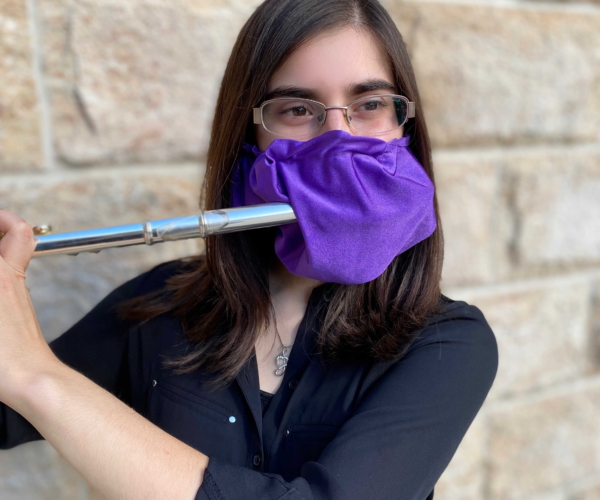Allowing student musicians and school bands to play safely has been a challenge in K-12 schools during the COVID era.
One college has a solution administrators, music teachers and band leaders might want to copy.
At Nazareth College in Rochester, New York, specialized masks students can wear while playing flutes, trumpets and other instruments are keeping music education alive.
The college’s School of Music faculty spent months designing and sewing the masks, which have small openings specialized to fit each students’ instrument.
More from DA: How music classes have gone digital since school closures
A flutist, for example, can play with no harm to sound quality because the fabric isn’t sitting on the instrument’s mouthpiece.
Students are required to wear their “playing masks” only during rehearsals, method classes, and when practicing on their own, both inside and outside.
Each student also uses a bell cover that acts as a mask for the instrument. They are made out of two layers of dense fabric with a filter that captures aerosols.
For instruments with a spit valve, students must capture the water on a Lysol-soaked rag or towelette.
Making safe spaces for music
The faculty arranged smaller ensembles so students could social distance while performing and are rehearsing outside as weather allows.
The Nazareth Wind Symphony and Symphonic bands, normally 50 to 65 students, had to be reduced. Symphonic band director Steven Zugelder created the new Night Flyer Band, which rehearses Wednesday nights, to bring each of the three bands down to 30 to 35 students.
When it is cold, bands rehearse onstage of Nazareth’s Beston Hall and then split into smaller ensembles and rehearse in new locations to allows for sufficient air circulation.
The directors of each ensemble also had to choose music that controls the number of students onstage at one time.
More from DA: How to successfully integrate the arts into STEM classrooms
“There is not a standard instrumentation for this reduced number of players,” said Jared Chase, director of the Nazareth Wind Symphony. “For example, a string orchestra may have five different instrument parts and a chorus typically has four parts, but a wind ensemble can have as many as 40 unique, separate parts.”
Tents have been set up outdoors on campus so students can practice without masks.
“Music is our livelihood, and in a world where nothing is certain, it helps to be able to express our emotions and enjoy something we hold so close to our hearts during this stressful time, while staying safe,” senior music education and music performance major Emma Clive said.









